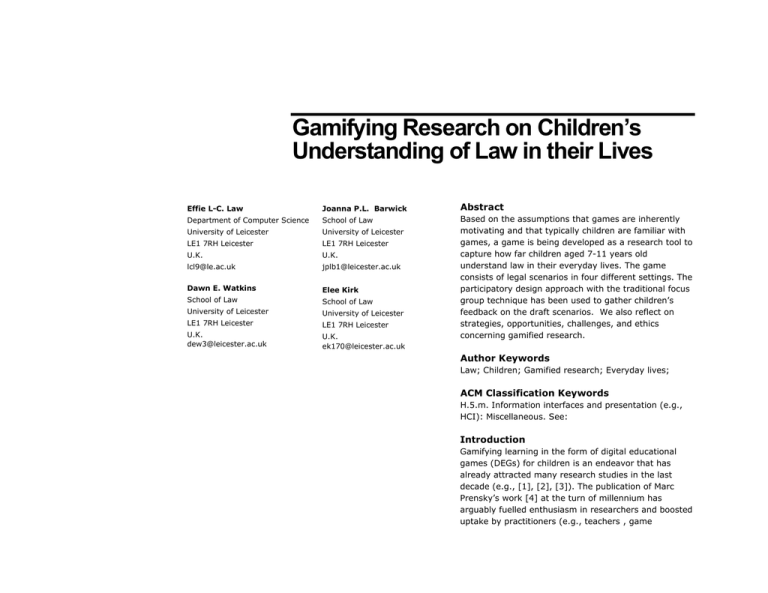Gamifying Research on Children`s Understanding of Law in their Lives
advertisement

Gamifying Research on Children’s Understanding of Law in their Lives Effie L-C. Law Joanna P.L. Barwick Abstract Department of Computer Science School of Law University of Leicester University of Leicester LE1 7RH Leicester LE1 7RH Leicester U.K. U.K. lcl9@le.ac.uk jplb1@leicester.ac.uk Dawn E. Watkins Elee Kirk School of Law School of Law University of Leicester University of Leicester LE1 7RH Leicester LE1 7RH Leicester U.K. dew3@leicester.ac.uk U.K. ek170@leicester.ac.uk Based on the assumptions that games are inherently motivating and that typically children are familiar with games, a game is being developed as a research tool to capture how far children aged 7-11 years old understand law in their everyday lives. The game consists of legal scenarios in four different settings. The participatory design approach with the traditional focus group technique has been used to gather children’s feedback on the draft scenarios. We also reflect on strategies, opportunities, challenges, and ethics concerning gamified research. Author Keywords Law; Children; Gamified research; Everyday lives; ACM Classification Keywords H.5.m. Information interfaces and presentation (e.g., HCI): Miscellaneous. See: Introduction Gamifying learning in the form of digital educational games (DEGs) for children is an endeavor that has already attracted many research studies in the last decade (e.g., [1], [2], [3]). The publication of Marc Prensky’s work [4] at the turn of millennium has arguably fuelled enthusiasm in researchers and boosted uptake by practitioners (e.g., teachers , game designers). In contrast, gamifying research with children is a more recent research effort with increasing interest. Both types of gamification activity are based on the assumption that games are inherently motivating and engaging and on the observation that digital games are an integral part of most children’s lives. Games, when well-designed, can sustain children’s attention, curiosity as well as cooperation in dealing with the given tasks or quests. Additionally, both activities are applied in a variety of domains, more prevalent in science and technology and relatively less in social sciences, arts and humanities. In this position paper, we report our newly launched research project – Law in Children’s Lives (LICL)1, utilizing games as a research tool to find out how children understand law in their everyday lives. In the following we present an overview of LICL and then discuss four issues pertaining to gamifying research strategies, opportunities, challenges, and ethics – as the focus of this workshop. Figure 1. Non-player character, Lex, of the LICL game. Overview of LICL According to [5], gamification is “the use of game design elements in non-game contexts”. LICL is an 18month research project aiming to utilize the power of gamification to research with school children. The research method commonly used to elicit children’s understanding of a particular topic is semi-structured interview with or without the use of props (e.g., pictorial scenarios). However, there are some known drawbacks of this conventional approach, which is: i) time-consuming; ii) prone to the social desirability or experimenter effect [6]; (iii) difficult to engage children 1 www2.le.ac.uk/departments/law/research/law-in-childrens-lives in imagining scenarios vividly and responding accordingly. Digital games are deemed as a viable solution for these issues. The main goals of the LICL project are to examine children’s awareness of certain legal provisions that apply to them and to assess children’s perception of their being empowered by these laws in their everyday lives. The earlier related work has looked into these issues but rather from a law-first approach [7], assessing the level of children’s understanding of legal institutions and processes ([8], [9]) and the role of legal actors ([10]). In LICL we adopt a child-centred approach and are particularly interested in finding out how far children demonstrate legal competence in their decision-making. Currently, the LICL project is designing an android tablet-based game app for data collection. Four settings with which children are most familiar have been identified, namely school, shop, park, and a friend’s home, as micro-worlds of the game. In each of the settings, several scenarios are presented where children are expected to apply their legal competence to interpret the situations and make decisions accordingly. For instance, in a shopping scenario, after paying for an item a child unwraps its packaging and surprisingly finds that the item is faulty (e.g., a broken toy or a mouldy bar). What the child would choose to do (e.g., asking for refund, throwing away the item) and the rationale underlying the choice of action will be captured by the game through simple dialogues between the child and an alien, Lex (non-player character [11]; Figure 1). Through systematic analyses of such dialogues, the child’s understanding of the relevant law can be inferred. The target groups of the LICL project are children aged 7 to 11 years old. The game has been developed through participatory design [12] with a sample of 16 children from three primary schools, comprising two groups of dyads from each of the four school years (Year 3, 4, 5 and 6, covering the age bracket of 7-11). The children had been asked to comment on the scenarios, which were presented to them orally by a researcher. Then we adapted the scenarios. After the pilot phase, the main study with the executable game prototype will be conducted in a representative sample of schools in summer 2015. Children will play the game individually in the classroom and some also take the tablet home to play with their parents or carers. This presents the opportunity to interpret how children’s decision-making would be influenced by adults and vice versa - another innovative feature of the project. Discussion The workshop aims to reflect on the four aspects of gamifying research. We discuss them based on the insights hitherto gained from the planning and running of the LICL project. Strategies: Gamifying research, while being a recent trend, is not entirely new. The initiative “games with a purpose” (GWAP) dated back in 2006 can arguably be the pioneer work of gamified research. GWAPs2 such as Verbosity (a game for collecting common-sense facts) and Squigl (a game in which players trace the outlines of objects in photographs) are not bound to a particular discipline or domain. Games with simple rules and 2 www.cmu.edu/homepage/computing/2008/summer/gameswith-a-purpose.shtml graphical design could serve as GWAPs. Indeed, games as simple as tetris can be engaging. However, when a game is linked to a particular topic of a domain, it is essential to synthesize different perspectives and expertise in game design and domain-specific knowledge – a challenge proved rather tricky to resolve. Methodologically, it may not be adequate to rely solely on a gamified research tool for data collection. A mixed-method approach integrating the strengths of the traditional and gamified research techniques and tools is recommended. This can help triangulate empirical findings as well. Opportunities: Applying gamified applications to elicit responses from children, who may otherwise find it difficult to adopt the role depicted in the scenarios on legal and right-based issues, is deemed promising. With mobile technologies becoming more versatile, affordable and usable, the portability of the gamified research tool - the tabletbased game - is the opportunity that the LICL project taps to gather data in children’s home, stretching beyond the confine of a school setting. Another opportunity enabled by a gaming environment is the capture of multimodal data: textual, audio, video, and automatic logging. Nonetheless, research with children restricts the types of data (e.g., videos) to be collected unless special arrangements are made. Furthermore, as the game-based scenarios induce some sense of realism in the participants, who, when immersed in the game, may express their emotions somewhat naturally in their audio responses. This can facilitate the researcher to understand the children’s experience patterns. Project team biography The LCIL project is funded the Economic and Social Research Council (ESRC) in the UK. It is being led by Dr Dawn Watkins from the School of Law at the University of Leicester. Dawn is a former lawyer with expertise in family law and legal education. The other project members are: Dr. Effie Law, Reader, whose expertise is in HCI, focusing on user experience and usability methodologies, and in technology-enhanced learning, especially game-based learning; Dr Joanna Barwick, Research Associate, whose research interests are the social and cultural significance of games. Dr Elee Kirk, Research Associate, with expertise in using innovative research methods with young children; Challenges: Similar to the traditional research methods and tools, selecting representative samples for a gamified research study is critical for the validity and reliability of empirical data. Nonetheless, as games, despite their popularity, are not to everybody’s liking, assuming that gamified research works regardless of individual preferences can compromise the quality of empirical findings. Developing a gamified research tool involves a number of design decisions (e.g., 2D vs. 3D graphics), which are relevant to entertainment games as well. However, a particular challenge of developing a gamified research tool is to strike a balance between gaming and directing a player’s focus onto the topic in question. In other words, the game elements should not be too prominent or engaging lest they would distract the player from the main tasks. References Ethics: Like all research studies involving human participants, in developing and deploying a gamified research tool, potential ethical and moral issues need to be taken into serious consideration. In particular, the playful guise of the game may prompt the research participants to share unwittingly more than they otherwise would. To safeguard against this potential risk of manipulation, all participants (children, parents/carers) and stakeholders (teachers) must be well-informed about the purpose of the gamified research tool, the goal of the overall study, and their participation rights. Consent forms, written in a jargon-free and easy language, must be understood and signed by the participants. In LICL, individual legal scenarios will also be debriefed shortly after the game play session. [7] Fisher, R. J. (1993). Social desirability bias and the validity of indirect questioning. Journal of consumer research, 303-315. [1] Gee, J.P., 2003. What videogames have to teach us about learning and literacy. Basingstoke: Palgrave Macmillan [2] Squire, K. (2003). Video games in education. Int. J. Intell. Games & Simulation, 2(1), 49-62. [3] Law, E. L. C., & Sun, X. (2012). Evaluating user experience of adaptive digital educational games with Activity Theory. Int’l J. of Human-Computer Studies, 70(7), 478-497. [4] Prensky, M. (2003). Digital game-based learning. Computers in Entertainment (CIE), 1(1), 21-21. [5] Deterding, S. et al. (2011). Gamification. using game-design elements in non-gaming contexts. In CHI'11 EA (pp. 2425-2428). ACM. [6] Muller, M.J. (2007). Participatory design: The third space in HCI. In J. Jacko and A. Sears (Eds.), Handbook of HCI (2nd Ed.). Erlbaum. [8] Sarat, A., & Kearns, T.R. (1995). Law in everyday life. Michigan: University of Michigan Press. [9] Flin, R., Stevenson, Y., & Davies, G. (1989). Children's knowledge of court proceedings. British Journal of Psychology, 80, 285-297. [10] Peterson-Badali, M., Abramovitch, R. & Duda, J. (1997). Young children's legal knowledge and reasoning ability. Canadian Journal of Criminology, 39, 145-170. [11] Powell et al. (2008). Children’s perceptions of role of police: a qualitative study. International journal of police science and management, 10 (4), pp. 464-473. [12] Lankoski, P., & Björk, S. (2007). Gameplay design patterns for believable non-player characters. In Proc. DiGRA (pp. 416-423).

